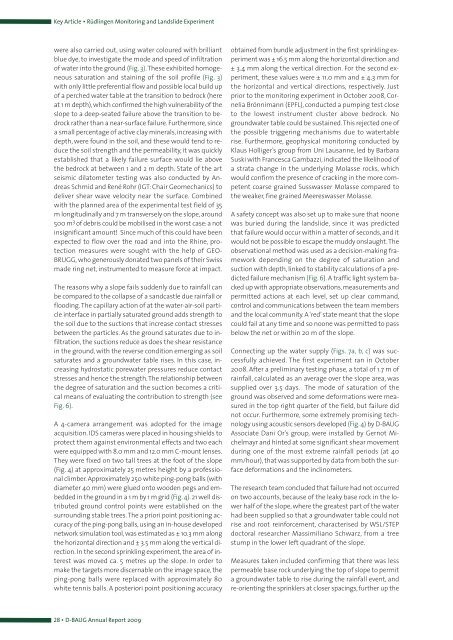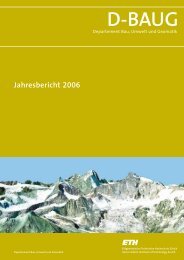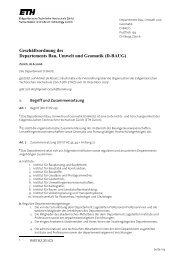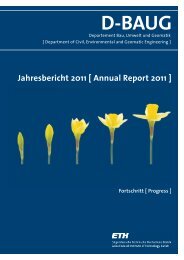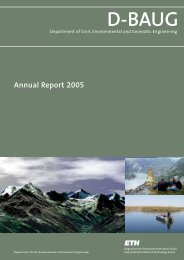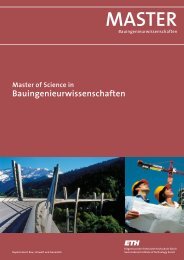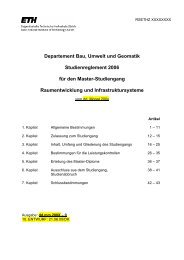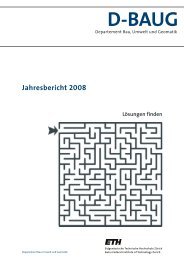D-BAUG - Departement Bau, Umwelt und Geomatik - ETH Zürich
D-BAUG - Departement Bau, Umwelt und Geomatik - ETH Zürich
D-BAUG - Departement Bau, Umwelt und Geomatik - ETH Zürich
Create successful ePaper yourself
Turn your PDF publications into a flip-book with our unique Google optimized e-Paper software.
Key Article ▪ Rüdlingen Monitoring and Landslide Experiment<br />
were also carried out, using water coloured with brilliant<br />
blue dye, to investigate the mode and speed of infiltration<br />
of water into the gro<strong>und</strong> (Fig. 3).These exhibited homogeneous<br />
saturation and staining of the soil profile (Fig. 3)<br />
with only little preferential flow and possible local build up<br />
of a perched water table at the transition to bedrock (here<br />
at 1 m depth), which confirmed the high vulnerability of the<br />
slope to a deep-seated failure above the transition to bedrock<br />
rather than a near-surface failure. Furthermore, since<br />
a small percentage of active clay minerals, increasing with<br />
depth, were fo<strong>und</strong> in the soil, and these would tend to reduce<br />
the soil strength and the permeability, it was quickly<br />
established that a likely failure surface would lie above<br />
the bedrock at between 1 and 2 m depth. State of the art<br />
seismic dilatometer testing was also conducted by Andreas<br />
Schmid and René Rohr (IGT: Chair Geomechanics) to<br />
deliver shear wave velocity near the surface. Combined<br />
with the planned area of the experimental test field of 35<br />
m longitudinally and 7 m transversely on the slope, aro<strong>und</strong><br />
500 m 3 of debris could be mobilised in the worst case: a not<br />
insignificant amount! Since much of this could have been<br />
expected to flow over the road and into the Rhine, protection<br />
measures were sought with the help of GEO-<br />
BRUGG, who generously donated two panels of their Swiss<br />
made ring net, instrumented to measure force at impact.<br />
The reasons why a slope fails suddenly due to rainfall can<br />
be compared to the collapse of a sandcastle due rainfall or<br />
flooding. The capillary action of at the water-air-soil particle<br />
interface in partially saturated gro<strong>und</strong> adds strength to<br />
the soil due to the suctions that increase contact stresses<br />
between the particles. As the gro<strong>und</strong> saturates due to infiltration,<br />
the suctions reduce as does the shear resistance<br />
in the gro<strong>und</strong>, with the reverse condition emerging as soil<br />
saturates and a gro<strong>und</strong>water table rises. In this case, increasing<br />
hydrostatic porewater pressures reduce contact<br />
stresses and hence the strength.The relationship between<br />
the degree of saturation and the suction becomes a critical<br />
means of evaluating the contribution to strength (see<br />
Fig. 6).<br />
A 4-camera arrangement was adopted for the image<br />
acquisition. IDS cameras were placed in housing shields to<br />
protect them against environmental effects and two each<br />
were equipped with 8.0 mm and 12.0 mm C-mount lenses.<br />
They were fixed on two tall trees at the foot of the slope<br />
(Fig. 4) at approximately 25 metres height by a professional<br />
climber. Approximately 250 white ping-pong balls (with<br />
diameter 40 mm) were glued onto wooden pegs and embedded<br />
in the gro<strong>und</strong> in a 1 m by 1 m grid (Fig. 4). 21 well distributed<br />
gro<strong>und</strong> control points were established on the<br />
surro<strong>und</strong>ing stable trees.The a priori point positioning accuracy<br />
of the ping-pong balls, using an in-house developed<br />
network simulation tool, was estimated as ± 10.3 mm along<br />
the horizontal direction and ± 3.5 mm along the vertical direction.<br />
In the second sprinkling experiment, the area of interest<br />
was moved ca. 5 metres up the slope. In order to<br />
make the targets more discernable on the image space, the<br />
ping-pong balls were replaced with approximately 80<br />
white tennis balls. A posteriori point positioning accuracy<br />
28 ▪ D-<strong>BAUG</strong> Annual Report 2009<br />
obtained from b<strong>und</strong>le adjustment in the first sprinkling experiment<br />
was ± 16.5 mm along the horizontal direction and<br />
± 3.4 mm along the vertical direction. For the second experiment,<br />
these values were ± 11.0 mm and ± 4.3 mm for<br />
the horizontal and vertical directions, respectively. Just<br />
prior to the monitoring experiment in October 2008, Cornelia<br />
Brönnimann (EPFL), conducted a pumping test close<br />
to the lowest instrument cluster above bedrock. No<br />
gro<strong>und</strong>water table could be sustained.This rejected one of<br />
the possible triggering mechanisms due to watertable<br />
rise. Furthermore, geophysical monitoring conducted by<br />
Klaus Holliger’s group from Uni Lausanne, led by Barbara<br />
Suski with Francesca Gambazzi, indicated the likelihood of<br />
a strata change in the <strong>und</strong>erlying Molasse rocks, which<br />
would confirm the presence of cracking in the more competent<br />
coarse grained Susswasser Molasse compared to<br />
the weaker, fine grained Meereswasser Molasse.<br />
A safety concept was also set up to make sure that noone<br />
was buried during the landslide, since it was predicted<br />
that failure would occur within a matter of seconds, and it<br />
would not be possible to escape the muddy onslaught.The<br />
observational method was used as a decision-making framework<br />
depending on the degree of saturation and<br />
suction with depth, linked to stability calculations of a predicted<br />
failure mechanism (Fig. 6). A traffic light system backed<br />
up with appropriate observations, measurements and<br />
permitted actions at each level, set up clear command,<br />
control and communications between the team members<br />
and the local community. A‘red’state meant that the slope<br />
could fail at any time and so noone was permitted to pass<br />
below the net or within 20 m of the slope.<br />
Connecting up the water supply (Figs. 7a, b, c) was successfully<br />
achieved. The first experiment ran in October<br />
2008. After a preliminary testing phase, a total of 1.7 m of<br />
rainfall, calculated as an average over the slope area, was<br />
supplied over 3.5 days. The mode of saturation of the<br />
gro<strong>und</strong> was observed and some deformations were measured<br />
in the top right quarter of the field, but failure did<br />
not occur. Furthermore, some extremely promising technology<br />
using acoustic sensors developed (Fig. 4) by D-<strong>BAUG</strong><br />
Associate Dani Or’s group, were installed by Gernot Michelmayr<br />
and hinted at some significant shear movement<br />
during one of the most extreme rainfall periods (at 40<br />
mm/hour), that was supported by data from both the surface<br />
deformations and the inclinometers.<br />
The research team concluded that failure had not occurred<br />
on two accounts, because of the leaky base rock in the lower<br />
half of the slope, where the greatest part of the water<br />
had been supplied so that a gro<strong>und</strong>water table could not<br />
rise and root reinforcement, characterised by WSL/STEP<br />
doctoral researcher Massimiliano Schwarz, from a tree<br />
stump in the lower left quadrant of the slope.<br />
Measures taken included confirming that there was less<br />
permeable base rock <strong>und</strong>erlying the top of slope to permit<br />
a gro<strong>und</strong>water table to rise during the rainfall event, and<br />
re-orienting the sprinklers at closer spacings, further up the


